1) Using nlme perform a regression separately for each level of C and then issue two coefplot calls.
library(nlme)
library(fixest)
L <- lmList(Y ~ G | C, df)
opar <- par(mfrow = 1:2)
ylim <- extendrange(unlist(confint(L)))
coefplot(L[[1]], col = "red", lwd = 2, ylim = ylim)
title(names(L)[1])
coefplot(L[[2]], col = "green", lwd = 2, ylim = ylim)
title(names(L)[2])
par(opar)
(continued after chart)

2) or maybe this is what you want. L and ylim are from above
coefplot(L[[1]], col = "green", x.shift = -0.2, ylim = ylim)
coefplot(L[[2]], add = TRUE, col = "red", x.shift = 0.2)
legend("topright", legend = names(L), col = c("green", "red"), lty = 1)
(continued after chart)

3) Another approach is to use the model shown here.
fm <- lm(Y ~ C / G + 0, transform(df, C = factor(C)))
nms <- variable.names(fm)
ix <- grep("G", nms)
g <- list(intercept = nms[-ix], slope = nms[ix])
coefplot(fm, group = g)

Note
The input used in reproducible form is
df <- structure(list(Y = c(0.677570635452867, 0.572633401956409, 0.102924682665616,
0.899824970401824, 0.24608773435466, 0.0420595335308462, 0.327920719282702,
0.954503649147227, 0.889539316063747, 0.6928034061566, 0.640506813768297,
0.994269776623696, 0.655705799115822, 0.708530468167737, 0.544066024711356,
0.59414202044718, 0.28915973729454, 0.147113647311926, 0.963024232536554,
0.902299045119435, 0.690705278422683, 0.795467417687178, 0.0246136845089495,
0.477795971091837, 0.758459537522867, 0.216407935833558, 0.318181007634848,
0.231625785352662, 0.142800022382289, 0.414546335814521, 0.413724326295778,
0.368845450924709, 0.152444747742265, 0.13880606344901, 0.233034099452198,
0.465962450252846, 0.265972640365362, 0.857827715342864, 0.0458311666734517,
0.442200074205175, 0.798924845643342, 0.12189925997518, 0.560947983758524,
0.20653138961643, 0.127531650243327, 0.753307864302769, 0.895045359153301,
0.374462775886059, 0.665115194628015, 0.0948406609240919, 0.383969637798145,
0.27438364457339, 0.814640038879588, 0.448516341391951, 0.810064353048801,
0.812389509519562, 0.794342321110889, 0.439831687603146, 0.754475158639252,
0.629221131559461, 0.710182401351631, 0.000624773325398564, 0.475316574098542,
0.220118885161355, 0.379816537722945, 0.612771003274247, 0.351797909243032,
0.111135424347594, 0.243619472719729, 0.66805558744818, 0.417646779678762,
0.788195834029466, 0.102864644257352, 0.434892741497606, 0.984956979984418,
0.893051114398986, 0.886469060787931, 0.175052650272846, 0.130695691565052,
0.653101925039664, 0.343516472261399, 0.656758127966896, 0.320373242488131,
0.187691119266674, 0.782294301316142, 0.0935949867125601, 0.46677904156968,
0.511505459900945, 0.59998895926401, 0.332823540316895, 0.488613033667207,
0.954473827499896, 0.4829023971688, 0.890350222121924, 0.914438186911866,
0.608734982321039, 0.410689776530489, 0.147094690939412, 0.935299803270027,
0.301228899974376), G = c(0, 1, 1, 0, 1, 1, 1, 0, 1, 0, 0, 0,
0, 1, 0, 0, 0, 1, 1, 1, 1, 1, 1, 1, 1, 1, 1, 0, 0, 0, 0, 0, 1,
0, 0, 0, 0, 1, 1, 0, 0, 0, 0, 0, 1, 0, 0, 0, 1, 0, 1, 0, 0, 1,
1, 0, 0, 0, 1, 0, 1, 1, 1, 1, 0, 1, 1, 1, 1, 0, 1, 0, 1, 0, 0,
1, 1, 1, 0, 0, 1, 1, 1, 0, 0, 1, 0, 1, 0, 1, 1, 1, 0, 1, 0, 0,
0, 0, 0, 0)), row.names = c(NA, -100L), class = "data.frame")




